As photographs of the new Honor 10. Compare with Huawei P20 and iPhone 7 Plus
Hi Geektimes! Your dear edition attended the presentation of the new smartphone, Honor 10, on May 15th. It is already on sale in China, and someone is probably transporting it to Russia, but now the official version has appeared, which will be sold for 27 or 30 thousand rubles. By today's standards, the line is still relatively budget, but the gadgets in it have top-end features. Under the cut, we will share our first impressions and compare the capabilities of the new camera with the flagship Huawei P20 and the not-so-young, but still relevant iPhone 7 Plus.
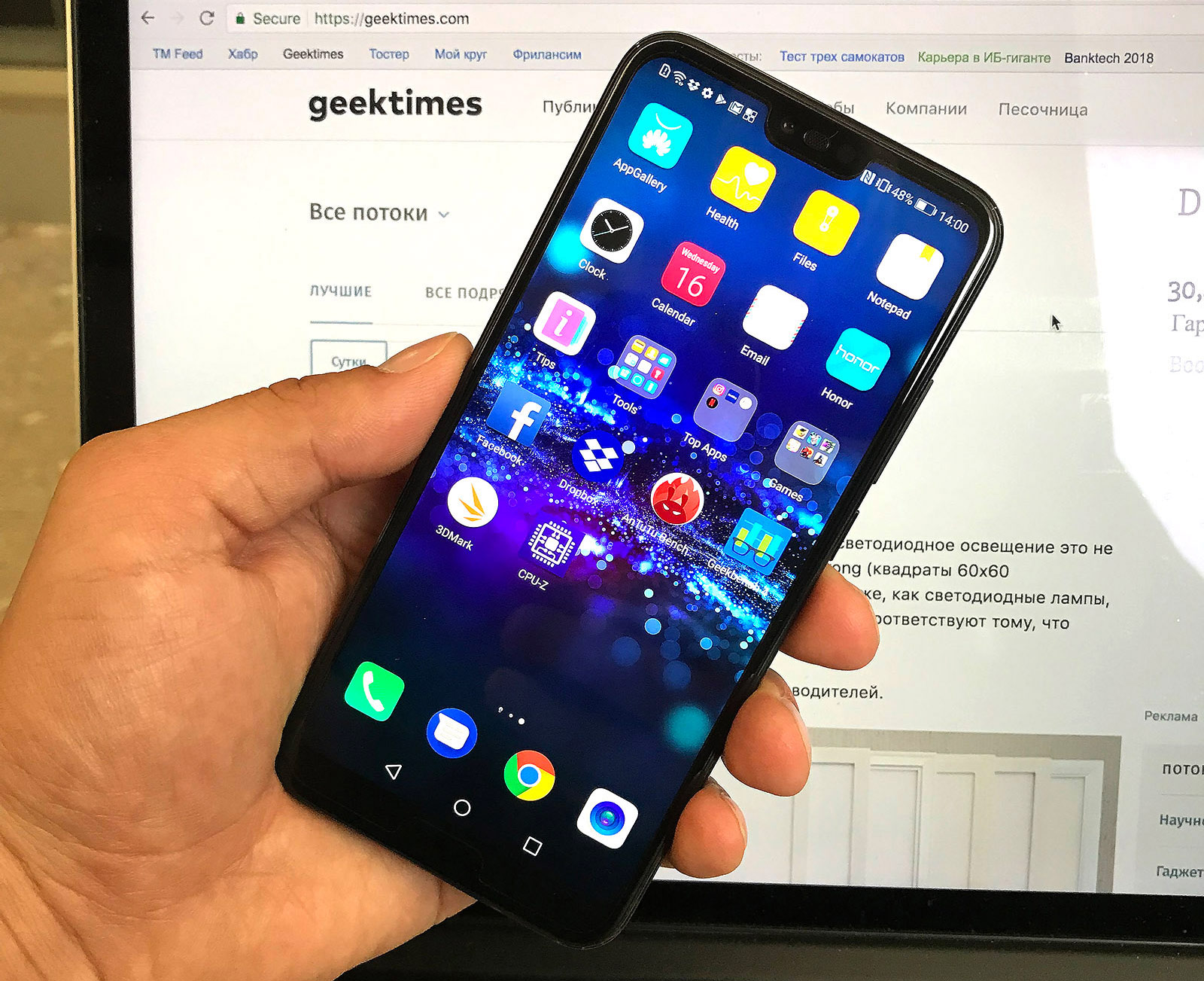
It seems that Huawei from the very beginning had some kind of tactics that the company adheres to. Every year in February, they have another flagship - Huawei P9, P10, and then P20. Then, after a couple of months, a smartphone under the Honor brand appears on the scene, which largely repeats the top model, but costs almost half the price. Last year, this was the case with Honor 9, which became the budget equivalent of the Huawei P10, and this time we have a cheaper copy of the Huawei P20. And since the current flagship turned out to be especially good in terms of the camera, then in the case of Honor 10 you can immediately count on wide photographic opportunities. True, the camera here is different - the same as it was in last year's Honor View 10.

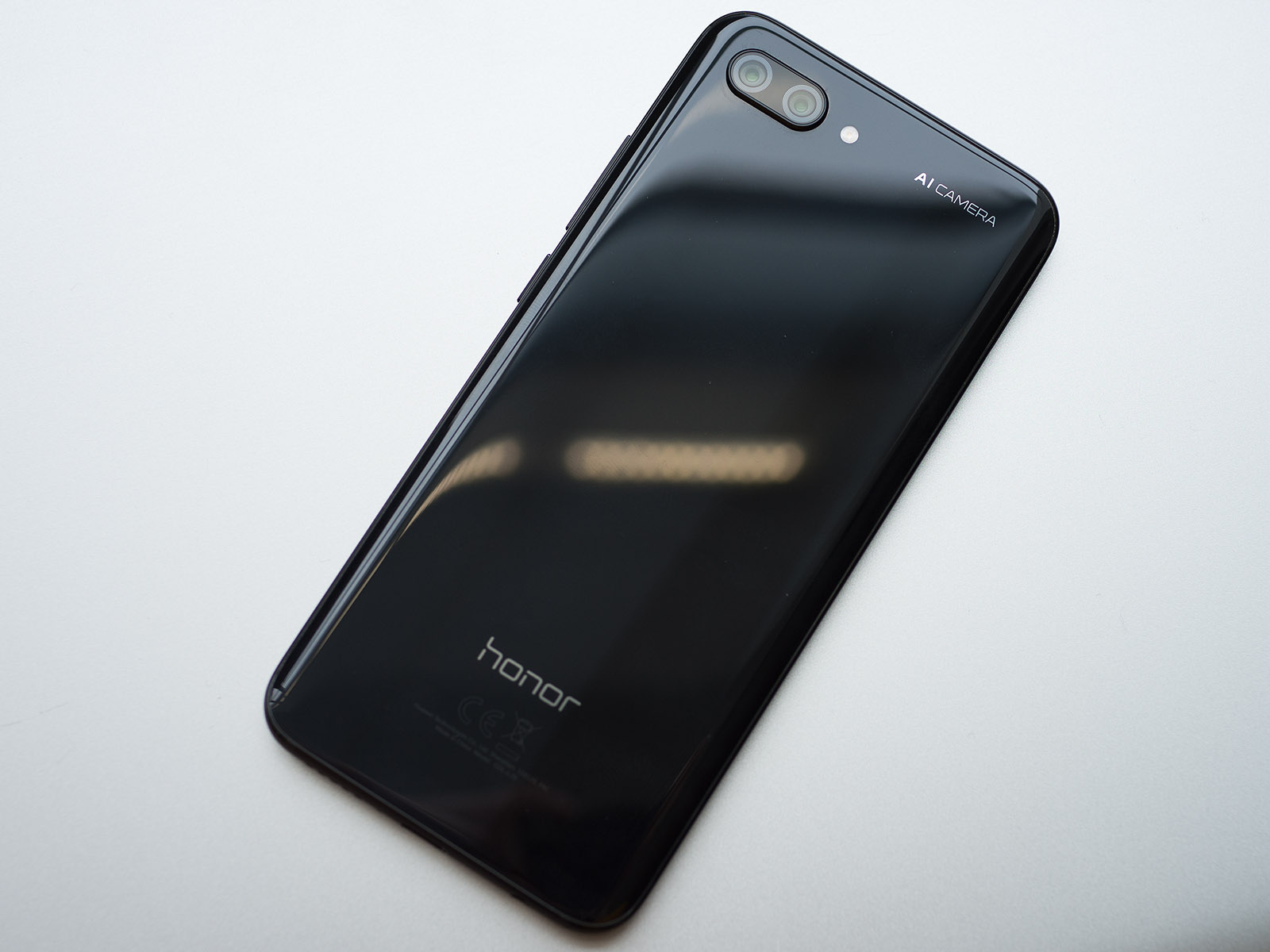
The first thing that surprised me very much was that despite the technological saturation of the device, it took almost 30 minutes from the hourly presentation to talk about the new colors of the case. A powerful processor with a separate module for neuroprocessing, a camera with artificial intelligence - all this, as it turned out, is not as important as a multi-layer glass cover of the case. In green and blue versions, the smartphone really looks bombed. However, they may not be called either green or blue, because when you tilt and rotate the case, the “back” of the smartphone sparkles with all the colors of the rainbow.

It looks good, but something tells you that Honor 10 in a black case will be more popular. This is exactly what we turned in our hands.
Honor 10 is a hodgepodge of all the relevant decisions of the last half year. The shape of the case and color solutions - like the Huawei P20, “monobrow” at the top edge of the screen - like the iPhone X, smoothly curved side edges (but not the screen itself) - like the Samsung Galaxy S9. It looks nice, in the hand (sorry for the obvious) it lies well and, being in the front pocket of jeans, does not interfere with walking.

But if in the same iPhone X Apple sought to make the screen as large as possible, abandoning even the button under the display and implementing a controversial notch on the screen, then in the case of Honor 10 it is just a fad. The ratio of the screen area to the area of the front surface here is not a record, but at the bottom there is a very wide indent with a fingerprint scanner. Well, how can you not ask: could you put the scanner behind, and take up the vacant space with the screen and not make this “bang”? Instead, we were given the option of programmatically disabling the protrusion. The areas of the screen to the right and left of it are simply highlighted in black, but the attentive eye will quickly notice the catch. On the Huawei P20 AMOLED screen, this still worked, but in Honor 10 they installed an IPS matrix with a diagonal of 5.85 inches. The aspect ratio, by the way, is a little non-standard - 19: 9, with a resolution of 2280 x 1080 pixels.
The fingerprint scanner is ultrasonic. It does not stand out against the background of glass tactilely - the active area is circled by engraving. But the main thing is that it works almost always correctly, even if the finger is wet, dirty or in a cream. The iPhone 7 Plus, which today costs about the same as asking for the Honor 10, loses noticeably in this regard. The scanner works like a touch button, just like in the Huawei P10 and P20.

We turn to the main feature of the smartphone - the built-in camera, or rather to the built-in cameras. There are two of them - now this is the standard not only for flagship devices, but also for middle-sized gadgets. The main (wide-angle) camera has a matrix with a resolution of 24 megapixels, the second (with a telephoto lens) - a more modest 16 megapixels. The aperture in both cases is f / 1.8. The second camera is built on the basis of a monochrome sensor, but it is constantly used in auxiliary mode, it allows you to more accurately analyze objects in the frame, and also helps simulate the bokeh effect and makes a very realistic background blur. True, here it is not superfluous to recall the Google Pixel 2, which perfectly does the same with a single camera. Take a look at the shooting examples, in this regard, the Honor 10 is quite good.







True, there is one subtlety. There is no optical stabilization, therefore, in low light, the Honor 10 removes naturally worse than the Huawei P20, but overall it’s not bad either. The only thing in which the tenth Honor is clearly inferior to the flagship is shooting a video; here the stabilizer is needed as air.

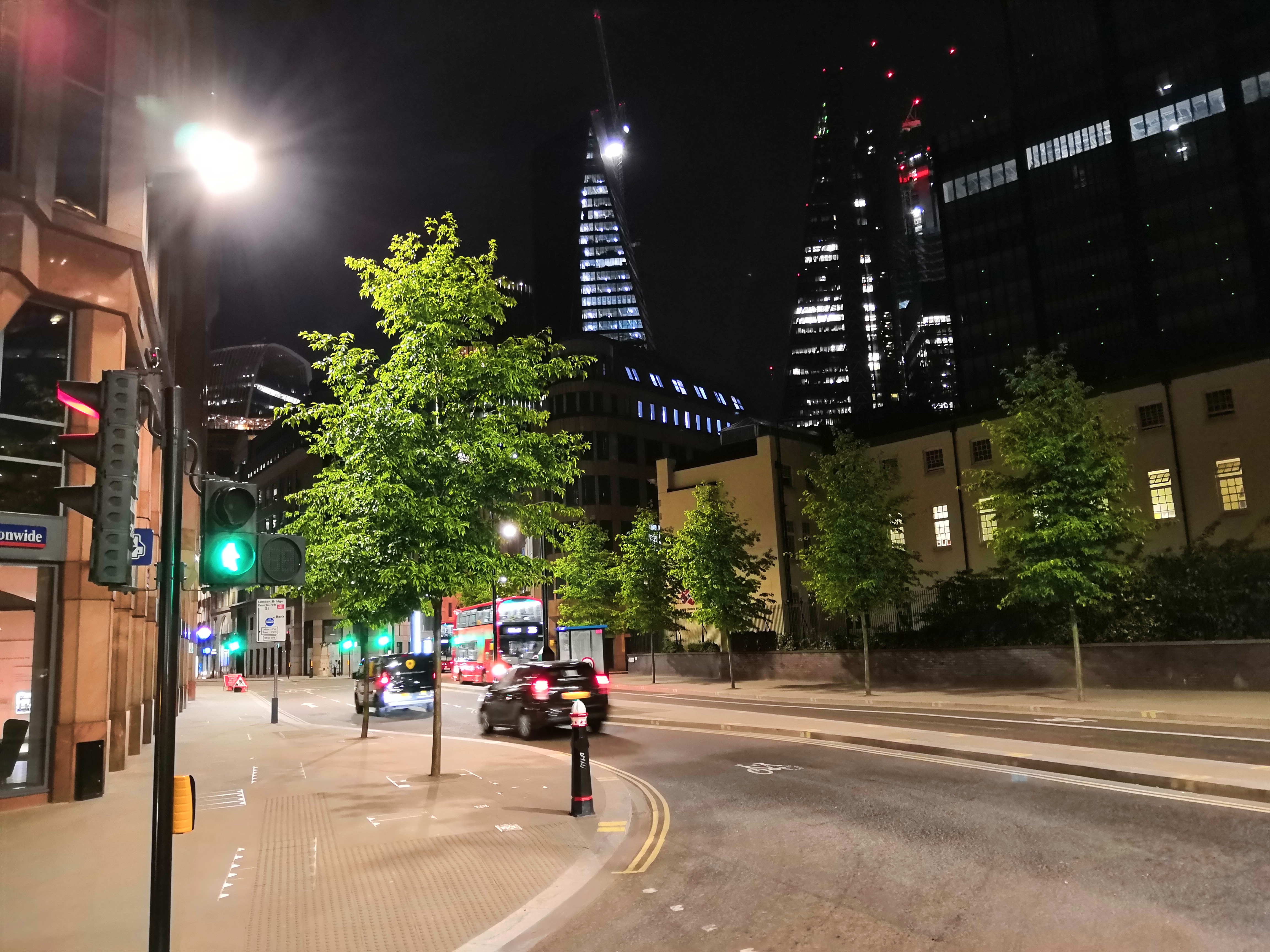

There is no Leica logo on the back of the case - this is the destiny of the top-end Huawei handsets, and in the case of Honor 10 we are greeted with the promising inscription AI Camera. There is a separate button in the camera interface, which at once includes all the capabilities of artificial intelligence. This leads to better recognition of typical scenes (food, city, landscape, night shooting, children, animals) and individual objects in the frame. After that, the algorithms apply point enhancers to different objects. For example, greenery becomes richer, the sky - more blue, even if you shoot against the sun. Well, in the case of portraits, skin irregularities are slightly removed, and the complexion becomes more healthy. This is not to say that the AI button works wonders, but most people are pretty happy with the result. Take a look for yourself.

In AI mode

In normal mode
Well, now let's see how the Honor 10 shows itself in comparison with the Huawei P20 and iPhone 7 Plus.
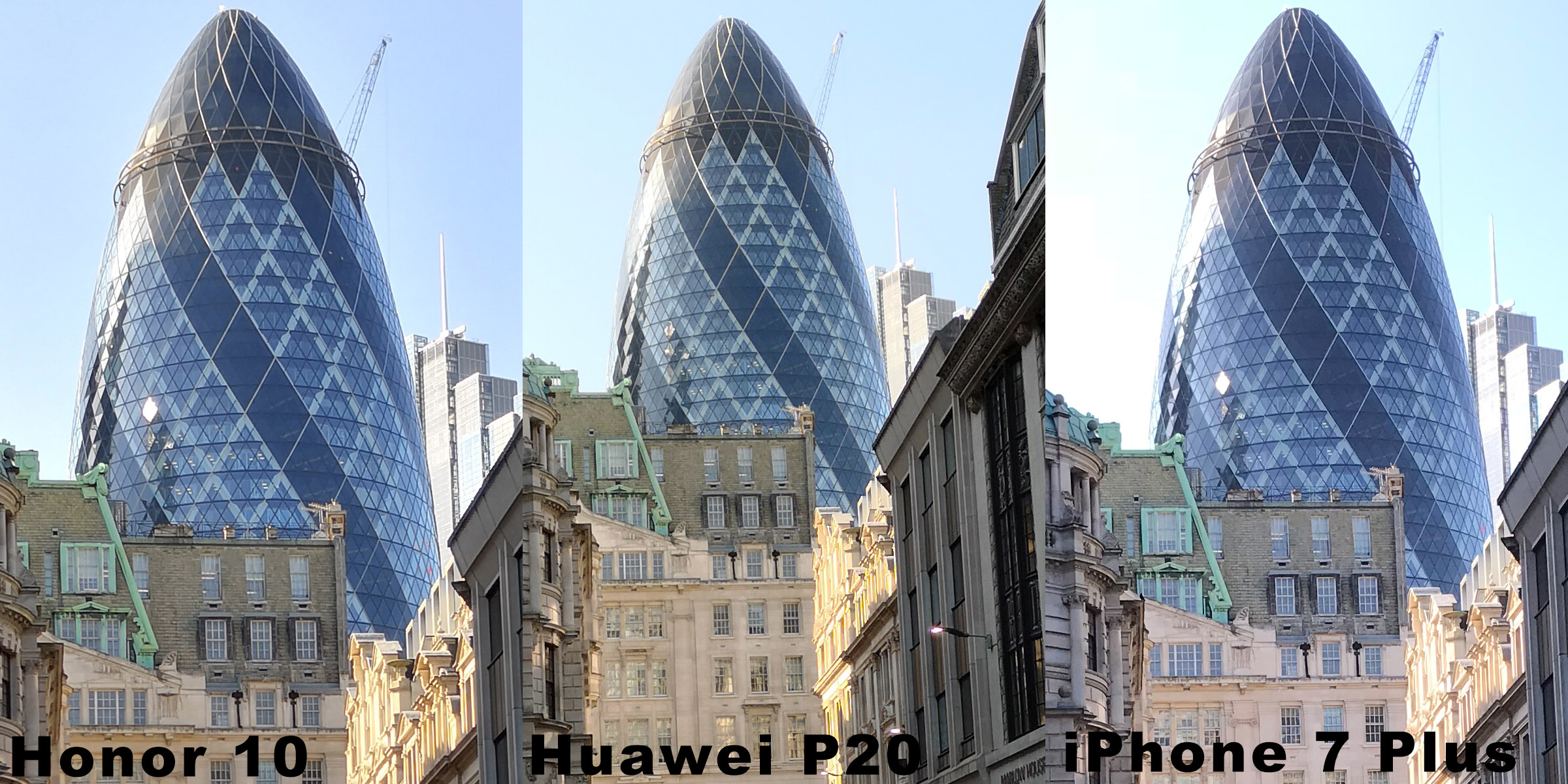
Originals: Honor 10 , Huawei P20 , iPhone 7 Plus

Originals: Honor 10 , Huawei P20 , iPhone 7 Plus
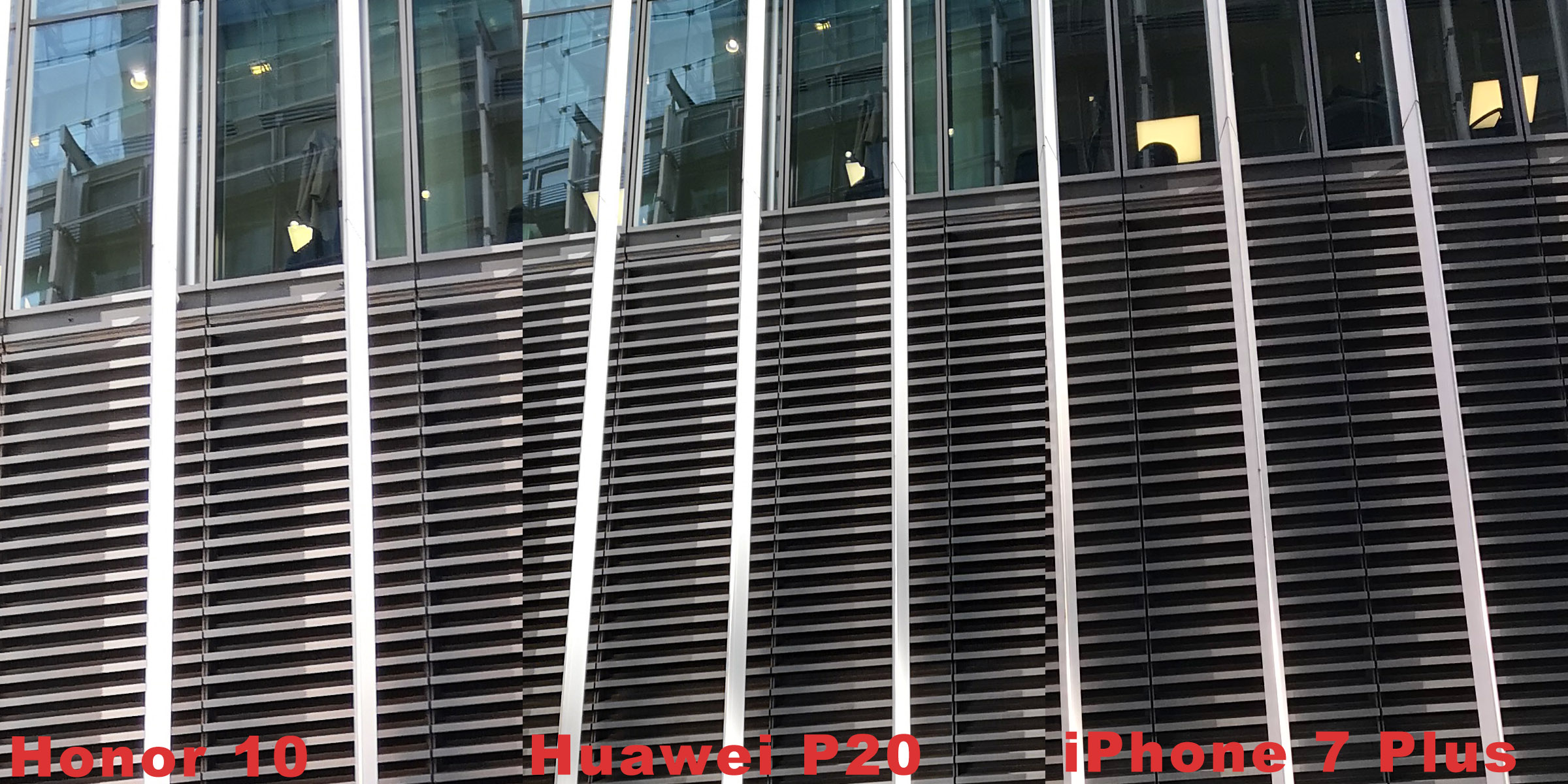
Originals: Honor 10 , Huawei P20 , iPhone 7 Plus
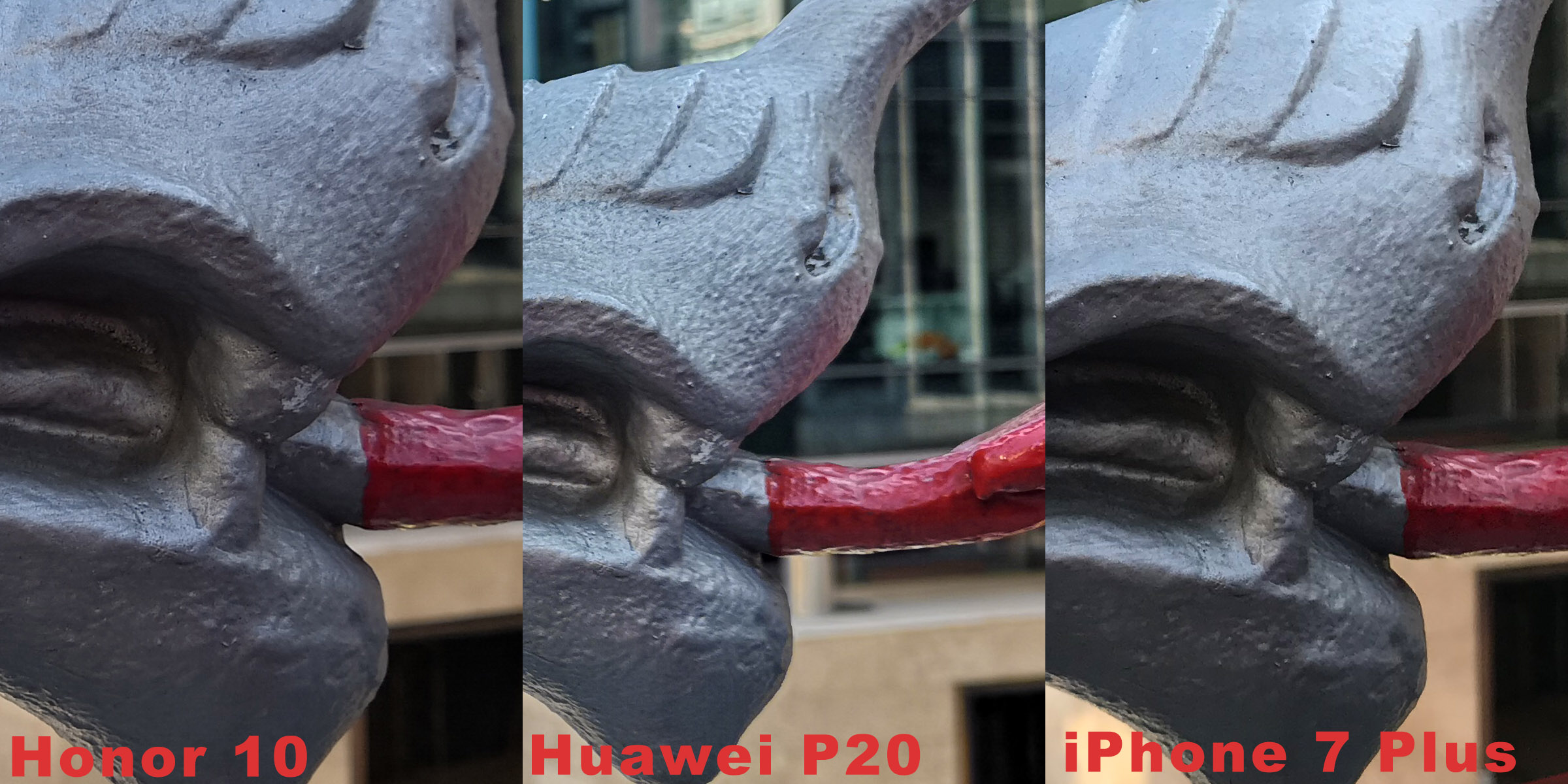
Originals: Honor 10 , Huawei P20 , iPhone 7 Plus
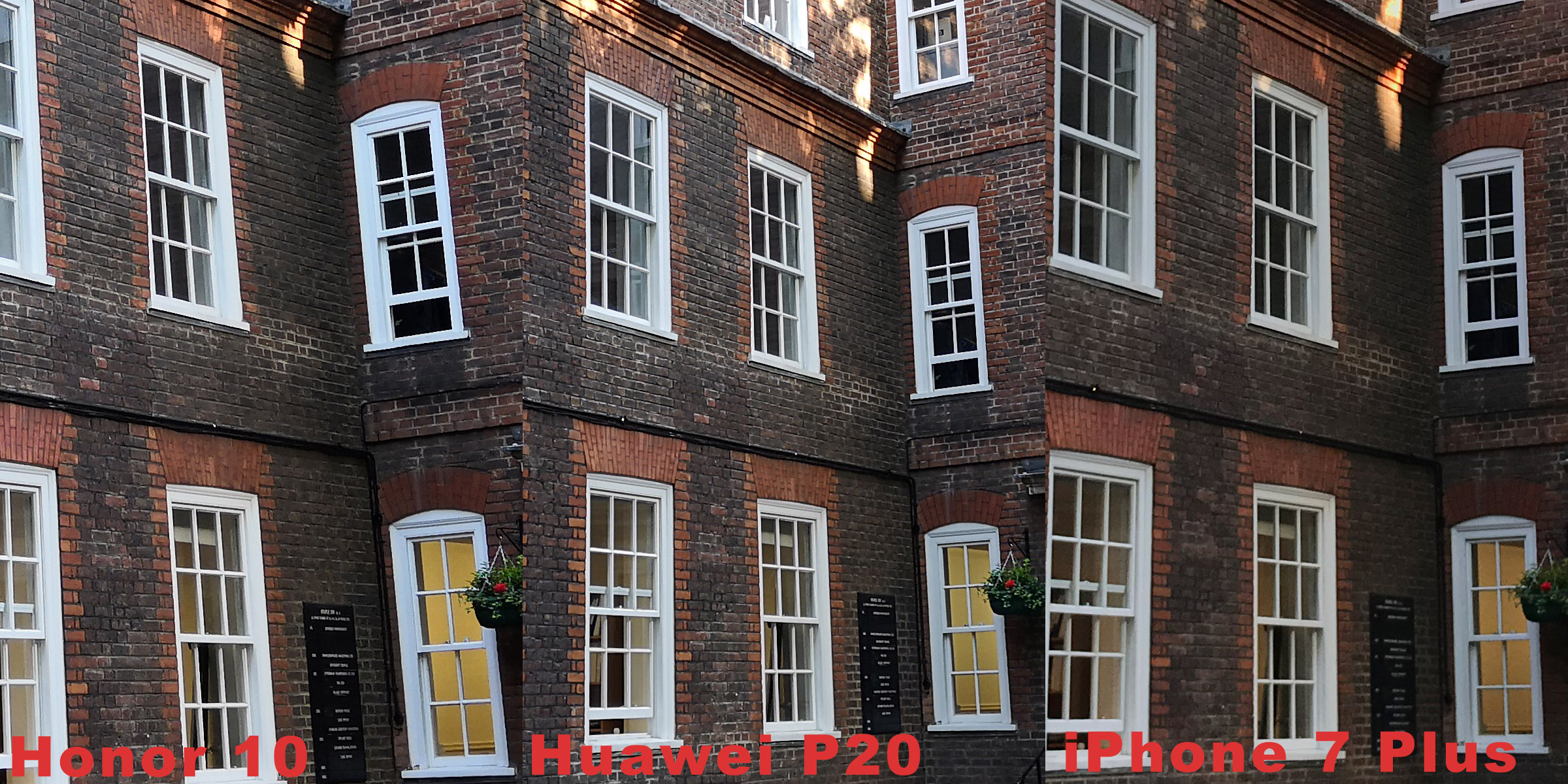
Originals: Honor 10 , Huawei P20 , iPhone 7 Plus
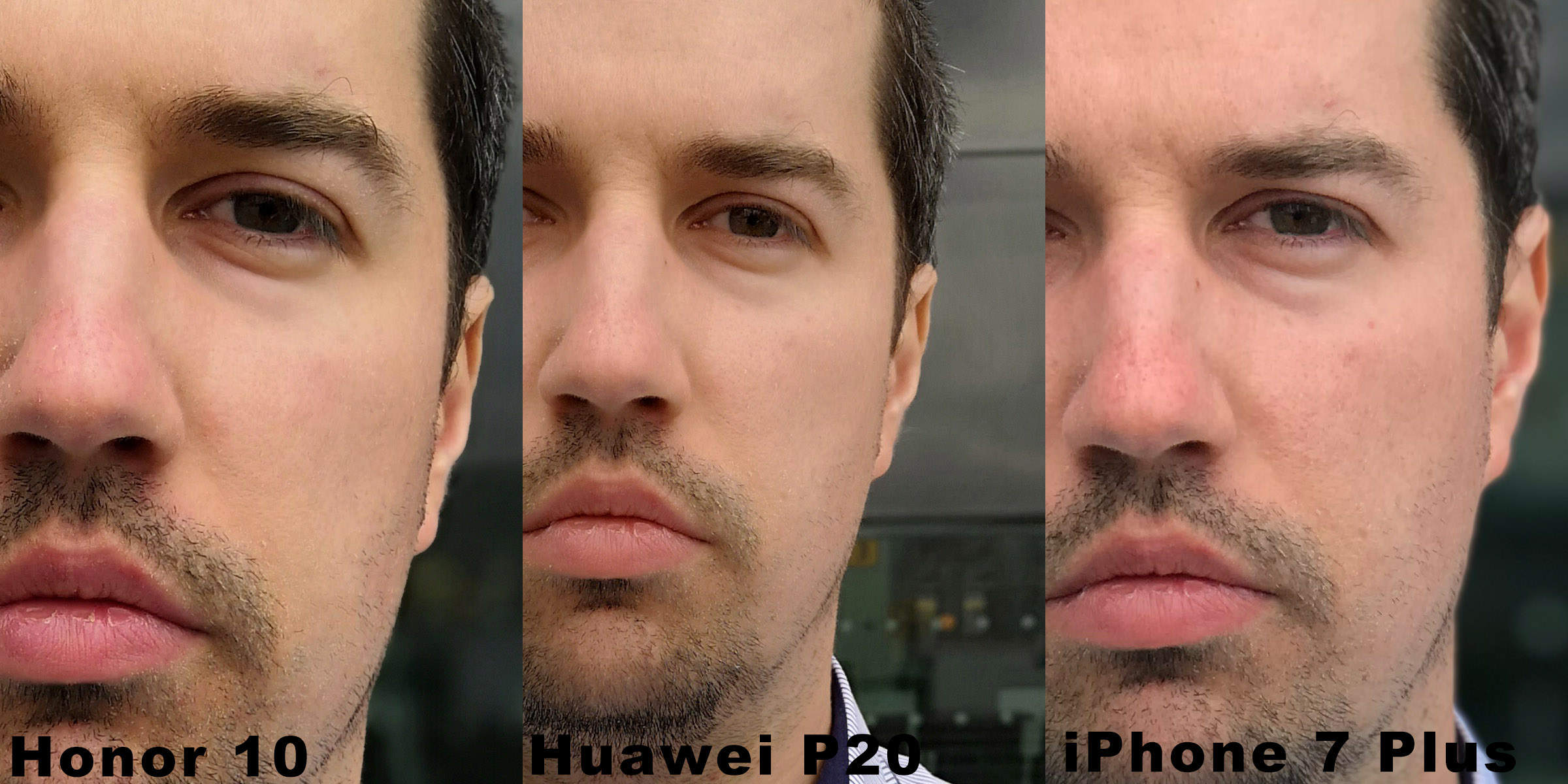
Originals: Honor 10 , Huawei P20 , iPhone 7 Plus
All fragments are shown at 100% magnification, and the difference in the size of objects in the frame is explained by the difference in resolution, so for a personal comparison, please note that size is not the main thing.
But the front camera of Honor 10 was inherited from the Huawei P20, and without any changes: it does not have autofocus, nor does it have a flash.

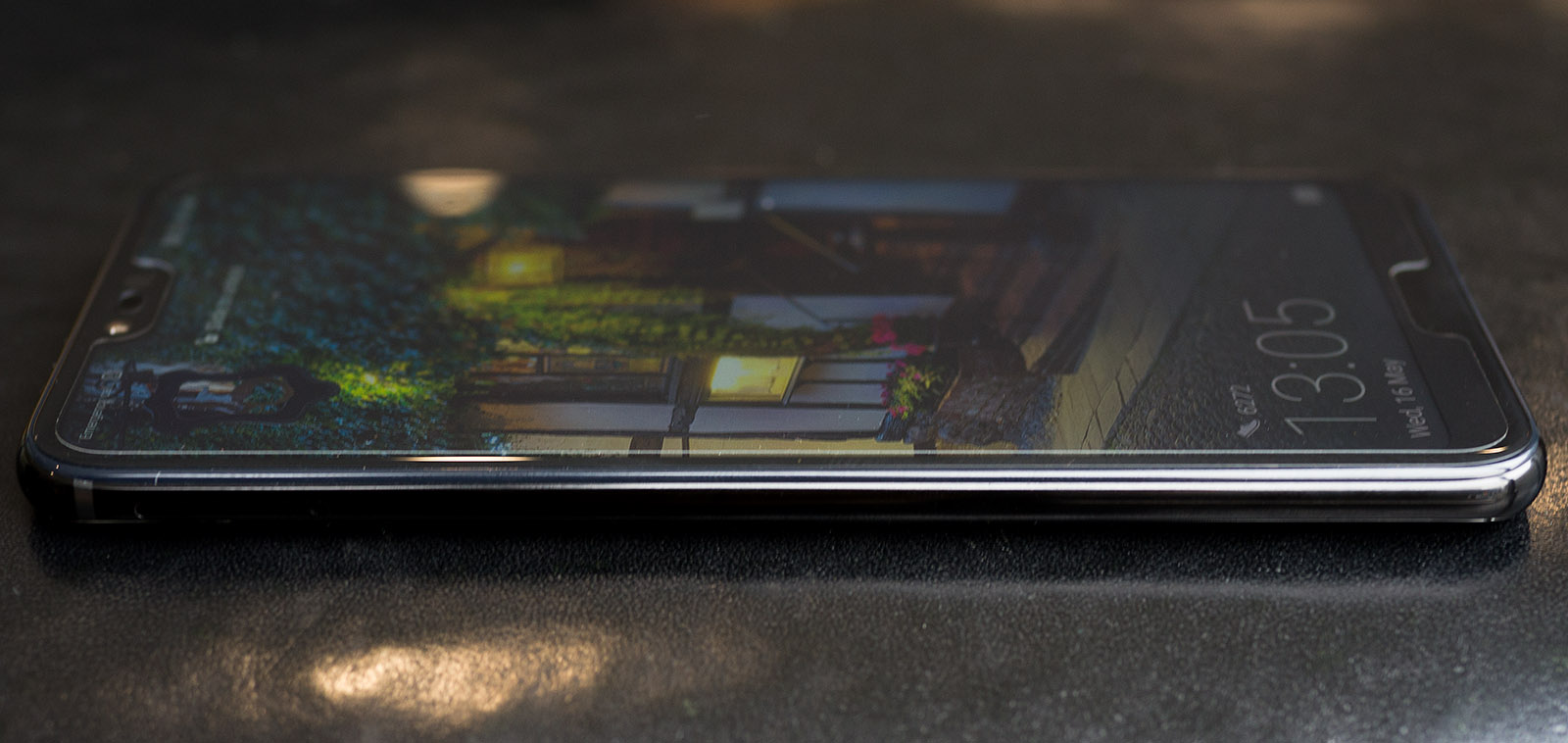
The hardware platform is the HiSilicon Kirin 970 system-on-chip with an eight-core central processor, a dedicated module for neural network computing, and a Mali-G72 MP12 graphics accelerator. The Russian Honor 10 models will have 4 GB of RAM, the amount of internal memory for storing data in the more affordable version of Honor 10 will be 64 GB, in the more expensive - 128 GB. In China (and in some other countries), a model with 6 GB of RAM will be released. If there was an expansion slot, there would be no point in buying a more expensive modification, but there is no expansion slot here.
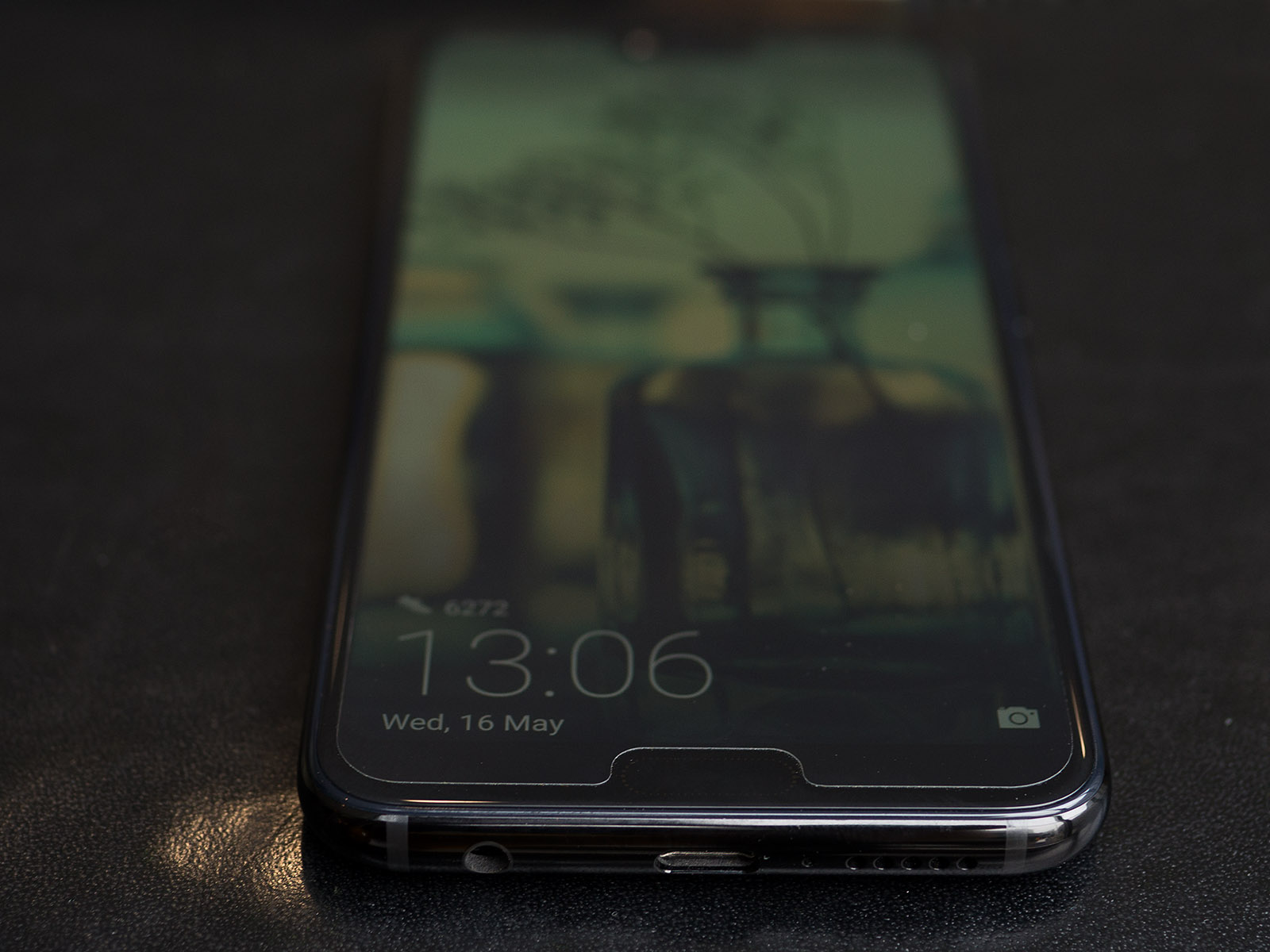

The battery (naturally, non-removable) has a capacity of 3 400 mAh, and this is enough for a whole day of active work. The standard adapter from the kit charges it from 0 to 100% in less than an hour and a half. Measured - it turned out exactly 80 minutes. The USB-C connector is used for charging, it also serves to connect a headset. So at the same time you can listen to music and charge the handset only with an adapter. Well, either it's just time to switch to wireless headphones.
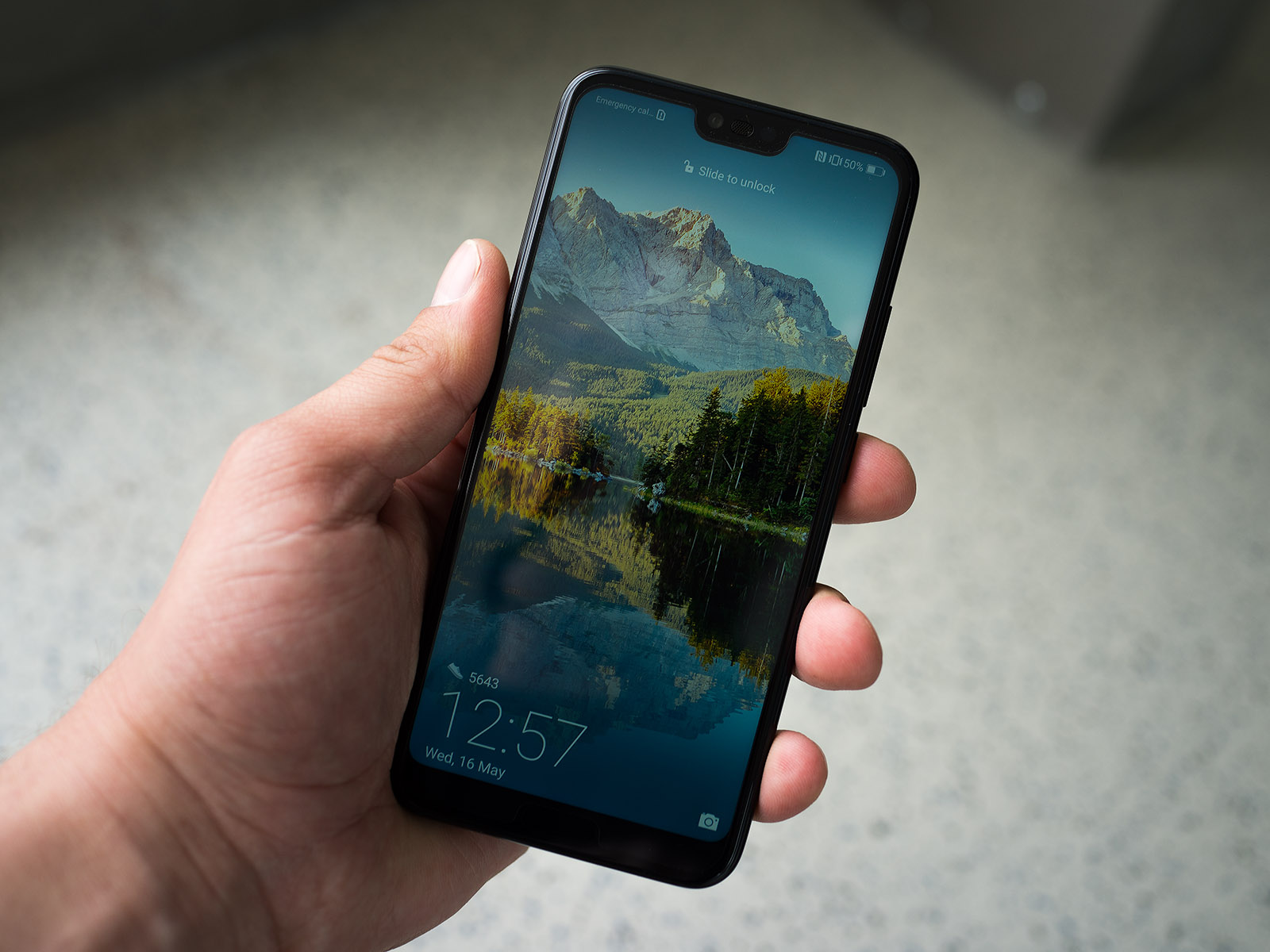
At the time of release, Honor 10 will be running Android 8.1 with the EMUI 8.0 shell. Whether there will be an upgrade to Android P is not yet known. But the prices have already been announced: for the version with 64 GB of memory they will ask for 27 thousand rubles, and 128 GB will cost 30 thousand rubles. Both modifications can already be found in Russia.

It seems that Huawei from the very beginning had some kind of tactics that the company adheres to. Every year in February, they have another flagship - Huawei P9, P10, and then P20. Then, after a couple of months, a smartphone under the Honor brand appears on the scene, which largely repeats the top model, but costs almost half the price. Last year, this was the case with Honor 9, which became the budget equivalent of the Huawei P10, and this time we have a cheaper copy of the Huawei P20. And since the current flagship turned out to be especially good in terms of the camera, then in the case of Honor 10 you can immediately count on wide photographic opportunities. True, the camera here is different - the same as it was in last year's Honor View 10.


Design
The first thing that surprised me very much was that despite the technological saturation of the device, it took almost 30 minutes from the hourly presentation to talk about the new colors of the case. A powerful processor with a separate module for neuroprocessing, a camera with artificial intelligence - all this, as it turned out, is not as important as a multi-layer glass cover of the case. In green and blue versions, the smartphone really looks bombed. However, they may not be called either green or blue, because when you tilt and rotate the case, the “back” of the smartphone sparkles with all the colors of the rainbow.

It looks good, but something tells you that Honor 10 in a black case will be more popular. This is exactly what we turned in our hands.
Honor 10 is a hodgepodge of all the relevant decisions of the last half year. The shape of the case and color solutions - like the Huawei P20, “monobrow” at the top edge of the screen - like the iPhone X, smoothly curved side edges (but not the screen itself) - like the Samsung Galaxy S9. It looks nice, in the hand (sorry for the obvious) it lies well and, being in the front pocket of jeans, does not interfere with walking.

But if in the same iPhone X Apple sought to make the screen as large as possible, abandoning even the button under the display and implementing a controversial notch on the screen, then in the case of Honor 10 it is just a fad. The ratio of the screen area to the area of the front surface here is not a record, but at the bottom there is a very wide indent with a fingerprint scanner. Well, how can you not ask: could you put the scanner behind, and take up the vacant space with the screen and not make this “bang”? Instead, we were given the option of programmatically disabling the protrusion. The areas of the screen to the right and left of it are simply highlighted in black, but the attentive eye will quickly notice the catch. On the Huawei P20 AMOLED screen, this still worked, but in Honor 10 they installed an IPS matrix with a diagonal of 5.85 inches. The aspect ratio, by the way, is a little non-standard - 19: 9, with a resolution of 2280 x 1080 pixels.
The fingerprint scanner is ultrasonic. It does not stand out against the background of glass tactilely - the active area is circled by engraving. But the main thing is that it works almost always correctly, even if the finger is wet, dirty or in a cream. The iPhone 7 Plus, which today costs about the same as asking for the Honor 10, loses noticeably in this regard. The scanner works like a touch button, just like in the Huawei P10 and P20.
Camera

We turn to the main feature of the smartphone - the built-in camera, or rather to the built-in cameras. There are two of them - now this is the standard not only for flagship devices, but also for middle-sized gadgets. The main (wide-angle) camera has a matrix with a resolution of 24 megapixels, the second (with a telephoto lens) - a more modest 16 megapixels. The aperture in both cases is f / 1.8. The second camera is built on the basis of a monochrome sensor, but it is constantly used in auxiliary mode, it allows you to more accurately analyze objects in the frame, and also helps simulate the bokeh effect and makes a very realistic background blur. True, here it is not superfluous to recall the Google Pixel 2, which perfectly does the same with a single camera. Take a look at the shooting examples, in this regard, the Honor 10 is quite good.







True, there is one subtlety. There is no optical stabilization, therefore, in low light, the Honor 10 removes naturally worse than the Huawei P20, but overall it’s not bad either. The only thing in which the tenth Honor is clearly inferior to the flagship is shooting a video; here the stabilizer is needed as air.



There is no Leica logo on the back of the case - this is the destiny of the top-end Huawei handsets, and in the case of Honor 10 we are greeted with the promising inscription AI Camera. There is a separate button in the camera interface, which at once includes all the capabilities of artificial intelligence. This leads to better recognition of typical scenes (food, city, landscape, night shooting, children, animals) and individual objects in the frame. After that, the algorithms apply point enhancers to different objects. For example, greenery becomes richer, the sky - more blue, even if you shoot against the sun. Well, in the case of portraits, skin irregularities are slightly removed, and the complexion becomes more healthy. This is not to say that the AI button works wonders, but most people are pretty happy with the result. Take a look for yourself.

In AI mode

In normal mode
Well, now let's see how the Honor 10 shows itself in comparison with the Huawei P20 and iPhone 7 Plus.

Originals: Honor 10 , Huawei P20 , iPhone 7 Plus

Originals: Honor 10 , Huawei P20 , iPhone 7 Plus

Originals: Honor 10 , Huawei P20 , iPhone 7 Plus

Originals: Honor 10 , Huawei P20 , iPhone 7 Plus

Originals: Honor 10 , Huawei P20 , iPhone 7 Plus

Originals: Honor 10 , Huawei P20 , iPhone 7 Plus
All fragments are shown at 100% magnification, and the difference in the size of objects in the frame is explained by the difference in resolution, so for a personal comparison, please note that size is not the main thing.
But the front camera of Honor 10 was inherited from the Huawei P20, and without any changes: it does not have autofocus, nor does it have a flash.
Filling


The hardware platform is the HiSilicon Kirin 970 system-on-chip with an eight-core central processor, a dedicated module for neural network computing, and a Mali-G72 MP12 graphics accelerator. The Russian Honor 10 models will have 4 GB of RAM, the amount of internal memory for storing data in the more affordable version of Honor 10 will be 64 GB, in the more expensive - 128 GB. In China (and in some other countries), a model with 6 GB of RAM will be released. If there was an expansion slot, there would be no point in buying a more expensive modification, but there is no expansion slot here.


The battery (naturally, non-removable) has a capacity of 3 400 mAh, and this is enough for a whole day of active work. The standard adapter from the kit charges it from 0 to 100% in less than an hour and a half. Measured - it turned out exactly 80 minutes. The USB-C connector is used for charging, it also serves to connect a headset. So at the same time you can listen to music and charge the handset only with an adapter. Well, either it's just time to switch to wireless headphones.

At the time of release, Honor 10 will be running Android 8.1 with the EMUI 8.0 shell. Whether there will be an upgrade to Android P is not yet known. But the prices have already been announced: for the version with 64 GB of memory they will ask for 27 thousand rubles, and 128 GB will cost 30 thousand rubles. Both modifications can already be found in Russia.
Main characteristics
- OS: Android 8.1 Oreo + Shell EMUI 8.0
- Display: IPS, diagonal - 5.84 ", resolution - 2280x1080
- Processor: HiSilicon Kirin 970, 8 cores (4x Cortex-A53 1.8 GHz + 4x Cortex-A73 2.36 GHz)
- Memory: 4/6 GB of RAM, 64/128 GB of internal memory for data storage
- Graphics: Mali-G72 MP12
- Communications: LTE Cat.13, 2G / 3G, Wi-Fi 802.11 b / g / n / ac, Bluetooth 4.2, GPS / GLONASS, Infrared, NFC
- Main camera: 16 megapixels, f / 1.8 with autofocus + 24 megapixels, f / 1.8, monochrome, without autofocus
- Front camera: 24 megapixels, f / 2.0, no autofocus
- Battery: Li-Pol, 3400 mAh
- Dimensions and Weight: 149.6 x 71.2 x 7.7 mm, 153 g
- Start of sales: May 15, 2018
